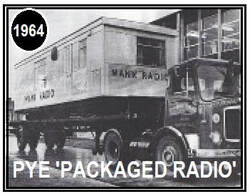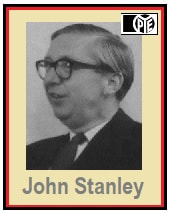|
Prince Charles explains 'pebble theatre'.
|
PEBBLE
|
|
Don Pierson [right] explains how a young Prince Charles made a request to join the Radio London fan club. |
|
|
Prince Charles explains 'pebble theatre'.
|
PEBBLE
|
|
Don Pierson [right] explains how a young Prince Charles made a request to join the Radio London fan club. |
|
 The story of PYE "packaged radio stations" that first saw major exposure in 1960 at two consecutive exhibitions, was timed to coincide with the hundreds of local radio station companies (and their subsidiaries), that were formed parallel to the anti-commercial radio and television drive by the GPO-BBC Pilkington Committee. That story about PYE "packaged radio stations" has been one of the most heavily censored media news stories of all time. We are not claiming that news stories did not exist, because we are reproducing some of them on this Blog. What we are claiming is that those news stories have been ignored by authors who have written about the history of British broadcasting. This is especially true as it relates to that period of time leading up to the ultra-secret creation of Radio Caroline. As we previously reported in parts 1c and 1d of this present series, there were eventually hundreds of radio stations seeking licenses at that time, and all were denied, except for Manx Radio. But the story of Manx Radio has been heavily censored, and its license only squeaked under the radar due to the special circumstances surrounding the laws governing the Isle of Man. That station began as a project to create a full-blown super-power operation known as 'Radio Manx', but it was toned down to the whimper known as 'Manx Radio'. Even so, that station was first hauled on to the landscape as self-contained "packaged radio station" from PYE. But contemporary press accounts merely shrugged it off as being in a "caravan". Journalists missed the real story by a mile! It was a "packaged radio station". Calling it a "caravan" gives the impression that this was merely a one-off mobile home that was put to another use, and not as just the packaging used for that particular station.  But what all of these stations waiting in the wings for licenses had in common, was their need for equipment, if they had been successful in getting British licenses. That is where PYE hoped to step-in as both the manufacturer and supplier of their requirements. More specifically, that is where Charles Orr Stanley handed over that phase to his son John Stanley. In addition to manufacturing and supplying, PYE also set out in detail where new radio stations could be established within the United Kingdom without causing interference. Those prospective stations were detailed in both text and maps within a publication called the 'PYE Plan for Local Broadcasting'. That Plan was backed-up with research by a team from the USA who, since the early days of radio broadcasting in America, had been responsible for the creation of similar plans in their own country.  PYE maintained a working relationship with that company from the time that PYE recommenced its new campaign for UK sponsored commercial radio and television, half-way through World War II. Those plans were then used in conjunction with relatively low-cost, production-line radio and television stations ready to be loaded on to a truck; a train or a ship, and then transported anywhere in the world. PYE did successfully sell some of these stations to other countries.  Nicholas Stanley, who is the grandson of Charles Orr Stanley, and son of John Stanley, commissioned a book that supposedly recreated the history of the PYE Group of companies, which, according to him, had been destroyed when various parts of the PYE Group were absorbed by Phillips. Unfortunately, he assigned the job of writing his book to a journalist who did not understand the subject matter he was writing about. To assist him, a technical writer was also brought in. However, the author Mark Frankland was working on a manuscript which covered far more than the subject of broadcasting. PYE was a group of companies making a vast number of consumer; military; industrial, and nautical products. Frankland drew upon existing published works about these subjects, as well as a scattered collection of PYE documents, to create his work. One of these documents had been created by Nicholas Stanley; son of John Stanley and grandson of Charles Orr Stanley. On page 276 of the book 'Radio Man' which was funded by Nicholas Stanley to the tune of approximately £100,000, is a single paragraph which, when read 'as is', makes no sense whatsoever. It cost us both time and money to uncover what this book was concealing, and how it had been concealed. But why it was concealed, primarily by Nicholas Stanley himself by misdirection, we still don't know. It all centered upon one man named Alan Bednall and three pages of an interview that Nicholas Stanley had personally undertaken in the home of Alan Bednall. We have previously published that document on 4/7/2020 with the Blog edition heading of 'Meet Alan Bednall'. We have extracted the relevant and verbatim information as it relates to Radio Caroline, and placed it within the composite picture shown below: Based upon what has been published to date by many authors, and what has been broadcast in many documentaries, the statement by Alan Bednall is at odds with them all. Either he lied, or he told the truth.
But Bednall's account is also at odds with the paragraph that was published on page 276 of the book 'Radio Man'. However, once other previously hidden information is also factored in, the contradictions disappear. What is now important is to discover missing pieces of information that support what Alan Bednall really told Nicholas Stanley! But that raises another major question: How can you find something when you don't know exactly what it is that you are looking for? The answer to that riddle is actually quite funny, because one of the most important 'keys' is hidden in plain sight, and we have now republished it several times on this Blog! However, we have have deliberately avoided drawing attention to it, thus far! The reason why we have not connected those dots so far (but we will), has to do with the microscopic way in which we have been examining the cold case evidence. We are not going to engage in 'guilt by association' or wild conspiracy theories, because we are going to use academic and police standards of documentation that first require the laying down of precedent to which other documented evidence can be joined. Having been previously ripped-off by so many plagiarists, we have been very clear about the fact that what we are doing is unique. It has not been done before and this evidence has not been assembled in this way before. There is a distinct "them" and "us" approach to this work. It will eventually be assembled in the first book in a new series that will be published later this year with the working title of 'Dial 999 for Caroline'. More on this theme in part 3, tomorrow. Comments are closed.
|
Our team produced this free radio program for PCRL in Birmingham.
It was repeatedly broadcast on and after October 20, 1985. Click & listen! Blog Archive
August 2023
Copyright 2021 with all rights reserved.
|
Index |
Library |
|
